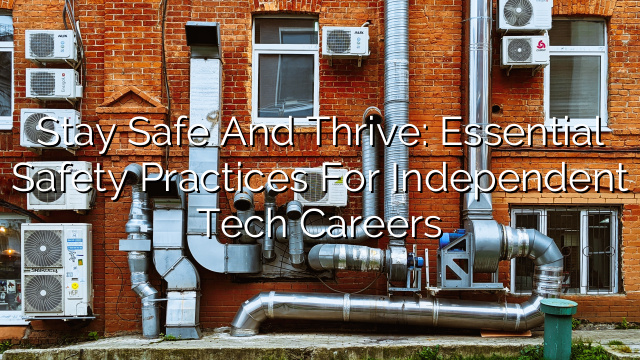The Importance of Safety Gear: Non-negotiable Items for Every Job Site
When it comes to working on a job site, safety should always be the top priority. Regardless of the type of job or industry, accidents can happen at any time, and one of the best ways to protect yourself and your team is by ensuring everyone is equipped with the proper safety gear. In this article, we will discuss the importance of safety gear and highlight the non-negotiable items that should be present on every job site.
Why is Safety Gear Important?
Working with heavy machinery, hazardous materials, or in challenging environments exposes workers to various risks. Safety gear helps mitigate these risks by providing protection against potential injuries and accidents.
Wearing safety gear is not just about complying with regulations; it is about ensuring the well-being of every individual on the job site. Investing in and using the right safety gear can prevent life-threatening injuries, reduce the severity of accidents, and improve overall safety performance.
Non-Negotiable Safety Gear Items for Every Job Site
While the specific safety gear requirements may vary based on the job and industry, there are certain non-negotiable items that should be present on every job site. These items are designed to provide fundamental protection and should be readily available and used by all workers.
- Hard Hats: A hard hat is essential for protecting the head from falling objects, electrical hazards, and impact injuries. It should be worn at all times on the job site, especially in areas where there is a risk of objects falling from above or overhead hazards.
- Safety Glasses/Goggles: Safety glasses or goggles protect the eyes from flying debris, chemicals, and other hazards that could cause eye injuries. They should be worn when performing tasks that involve grinding, drilling, cutting, or any activity that poses a risk to the eyes.
- Ear Protection: Exposure to loud noises on job sites, such as construction sites or factories, can cause hearing damage. Wearing ear protection, such as earplugs or earmuffs, can help reduce the risk of hearing loss.
- Work Boots: Proper footwear, such as steel-toed work boots, is crucial for protecting the feet from heavy objects, sharp materials, and potential electrical hazards. Work boots should have slip-resistant soles, ankle support, and meet all safety standards.
- High-Visibility Clothing: High-visibility clothing, often in the form of vests or jackets, is important for workers who are exposed to traffic or moving equipment. It makes workers more visible and reduces the risk of accidents due to low visibility.
- Gloves: Gloves provide hand protection against cuts, burns, chemicals, and other hazards. Different gloves are designed for specific tasks, so it’s important to choose the right type of gloves based on the job requirements.
- Fall Protection: For jobs that involve working at heights, fall protection gear is crucial. This may include safety harnesses, lanyards, and lifelines to prevent falls and protect against serious injuries.
- Respirators: In environments with airborne pollutants, dust, or hazardous materials, respirators are necessary to protect the respiratory system. Different types of respirators are available based on the level of filtration required.
Choosing the Right Safety Gear
When selecting safety gear for your job site, it is important to consider the specific hazards and risks associated with the job. Here are some factors to keep in mind:
- Compliance: Ensure that the safety gear meets all relevant compliance standards and regulations.
- Quality: Invest in safety gear from reputable manufacturers to ensure its durability and effectiveness.
- Comfort: Workers are more likely to wear safety gear consistently if it is comfortable. Look for gear that fits well and allows for ease of movement.
- Training: Provide proper training to workers on the correct usage, maintenance, and storage of safety gear.
- Inspection: Regularly inspect and replace safety gear that is damaged or worn out.
Frequently Asked Questions (FAQs)
Q: Can I use old or damaged safety gear?
A: No, old or damaged safety gear may not provide adequate protection and can potentially fail when needed. It is important to regularly inspect and replace any damaged or worn-out gear.
Q: What should I do if the safety gear is uncomfortable to wear?
A: If the safety gear is uncomfortable, try different sizes or models that provide a better fit. Getting input from workers and involving them in the selection process can help find gear that is both safe and comfortable.
Q: Why is high-visibility clothing important?
A: High-visibility clothing makes workers more visible to others, especially in low-light conditions or areas with moving equipment. It reduces the risk of accidents and helps ensure the safety of workers working in close proximity to vehicles or machinery.
Q: Who is responsible for providing safety gear?
A: Employers are generally responsible for providing the necessary safety gear to their employees. It is important for employers to assess the hazards on the job site and provide appropriate gear to ensure worker safety.
Q: Can safety gear prevent all accidents?
A: While safety gear is designed to minimize the risk of accidents and injuries, it cannot guarantee complete protection. It is important to implement other safety measures, such as proper training, following protocols, and maintaining a safe work environment, to further reduce the likelihood of accidents.
In conclusion, safety gear is an essential aspect of every job site. It helps protect workers from potential hazards and reduces the risk of accidents and injuries. By providing and wearing the necessary safety gear, employers and workers can create a safer work environment and prioritize the well-being of everyone involved. Remember, safety should never be compromised, and using non-negotiable safety gear is a crucial step in ensuring a successful and incident-free work site.







